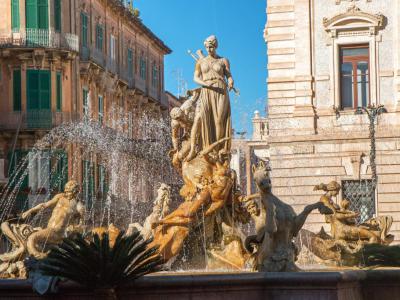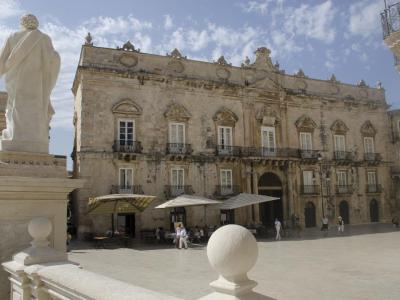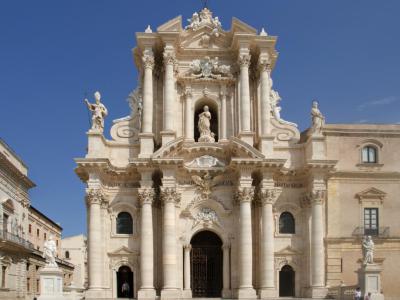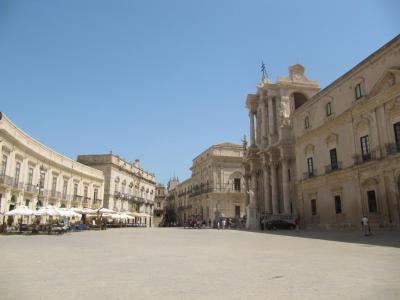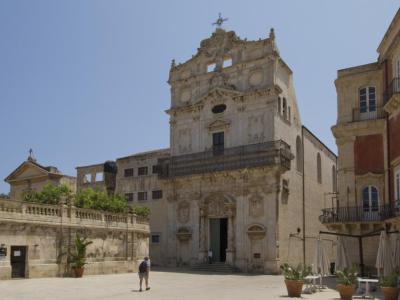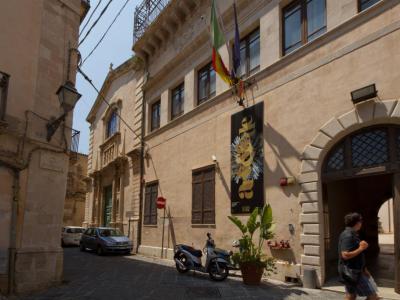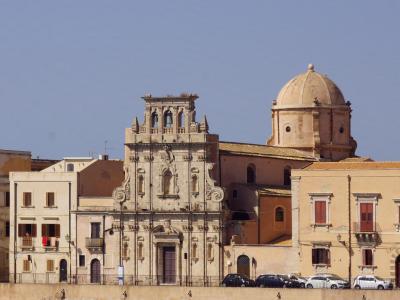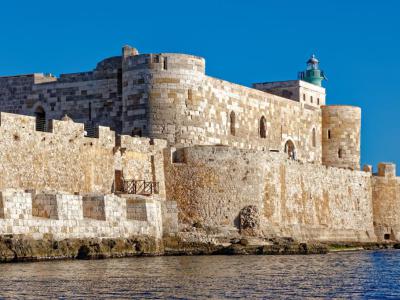Syracuse Introduction Walking Tour (Self Guided), Syracuse
Syracuse, a city steeped in 2,700 years of Greek and Roman history, boasts a rich cultural heritage, remarkable amphitheaters, and iconic architecture. It was the birthplace of the renowned mathematician and engineer Archimedes and played a pivotal role as a Mediterranean powerhouse in ancient times.
Founded by Ancient Greek Corinthians and Teneans, the city-state formed influential alliances with Sparta and Corinth, reigning supreme over the Greek-speaking coastal areas of Southern Italy (known as Magna Graecia). The Phoenicians are believed to have named it "Sour-ha-Koussim," meaning "Stone of the seagulls," which eventually gave rise to the name Syracuse.
Described by Roman writer Cicero as "the greatest Greek city and the most beautiful of them all," it rivaled Athens in size during the 5th century BC and later became part of the Roman Republic and Byzantine Empire. It even served as the Byzantine Empire's capital under Emperor Constans II (from 663 to 669).
Syracuse endured earthquakes in 1542 and 1693, a devastating plague in 1729, and significant damage during World War II bombings. Today a UNESCO World Heritage Site, the city also holds biblical significance, mentioned in the Acts of the Apostles, and celebrates its patron saint, Saint Lucy, on December 13.
One of the top attractions that captures the essence of Syracuse is the Cathedral of Syracuse, also known as the Duomo, which is a magnificent structure of Sicilian Baroque. This architectural marvel shares the Cathedral Square (Piazza Duomo) with the Church of Santa Lucia alla Badia, home to "The Burial of Saint Lucy" painting by Caravaggio, which makes it a significant destination for art enthusiasts.
Another place for art aficionados, the Bellomo Palace Regional Gallery, showcases an impressive collection of medieval and Renaissance art, including works by Antonello da Messina.
The Fountain of Arethusa (Fonte Aretusa) is a natural spring surrounded by lush greenery and is often associated with the Greek mythology of Arethusa, the revered patron figure of ancient Syracuse. It's a serene spot to relax and enjoy the tranquility of nature.
Last but not least, the Maniace Castle (Castello Maniace) is a medieval fortress that offers panoramic views of the city and the sea. It's a perfect location for history buffs and photographers alike.
In Syracuse, ancient myths and modern life coexist harmoniously. As you set out to explore the historical and cultural treasures of this city, rest assured that our self-guided journey will add a great deal of charm to your Mediterranean experience.
Founded by Ancient Greek Corinthians and Teneans, the city-state formed influential alliances with Sparta and Corinth, reigning supreme over the Greek-speaking coastal areas of Southern Italy (known as Magna Graecia). The Phoenicians are believed to have named it "Sour-ha-Koussim," meaning "Stone of the seagulls," which eventually gave rise to the name Syracuse.
Described by Roman writer Cicero as "the greatest Greek city and the most beautiful of them all," it rivaled Athens in size during the 5th century BC and later became part of the Roman Republic and Byzantine Empire. It even served as the Byzantine Empire's capital under Emperor Constans II (from 663 to 669).
Syracuse endured earthquakes in 1542 and 1693, a devastating plague in 1729, and significant damage during World War II bombings. Today a UNESCO World Heritage Site, the city also holds biblical significance, mentioned in the Acts of the Apostles, and celebrates its patron saint, Saint Lucy, on December 13.
One of the top attractions that captures the essence of Syracuse is the Cathedral of Syracuse, also known as the Duomo, which is a magnificent structure of Sicilian Baroque. This architectural marvel shares the Cathedral Square (Piazza Duomo) with the Church of Santa Lucia alla Badia, home to "The Burial of Saint Lucy" painting by Caravaggio, which makes it a significant destination for art enthusiasts.
Another place for art aficionados, the Bellomo Palace Regional Gallery, showcases an impressive collection of medieval and Renaissance art, including works by Antonello da Messina.
The Fountain of Arethusa (Fonte Aretusa) is a natural spring surrounded by lush greenery and is often associated with the Greek mythology of Arethusa, the revered patron figure of ancient Syracuse. It's a serene spot to relax and enjoy the tranquility of nature.
Last but not least, the Maniace Castle (Castello Maniace) is a medieval fortress that offers panoramic views of the city and the sea. It's a perfect location for history buffs and photographers alike.
In Syracuse, ancient myths and modern life coexist harmoniously. As you set out to explore the historical and cultural treasures of this city, rest assured that our self-guided journey will add a great deal of charm to your Mediterranean experience.
How it works: Download the app "GPSmyCity: Walks in 1K+ Cities" from Apple App Store or Google Play Store to your mobile phone or tablet. The app turns your mobile device into a personal tour guide and its built-in GPS navigation functions guide you from one tour stop to next. The app works offline, so no data plan is needed when traveling abroad.
Syracuse Introduction Walking Tour Map
Guide Name: Syracuse Introduction Walking Tour
Guide Location: Italy » Syracuse (See other walking tours in Syracuse)
Guide Type: Self-guided Walking Tour (Sightseeing)
# of Attractions: 9
Tour Duration: 1 Hour(s)
Travel Distance: 1.0 Km or 0.6 Miles
Author: DanaOffice
Sight(s) Featured in This Guide:
Guide Location: Italy » Syracuse (See other walking tours in Syracuse)
Guide Type: Self-guided Walking Tour (Sightseeing)
# of Attractions: 9
Tour Duration: 1 Hour(s)
Travel Distance: 1.0 Km or 0.6 Miles
Author: DanaOffice
Sight(s) Featured in This Guide:
- Fountain of Diana
- Beneventano del Bosco Palace
- Cathedral of Syracuse
- La Piazza Duomo (Cathedral Square)
- Church of Santa Lucia alla Badia
- Fonte Aretusa (Fountain of Arethusa)
- Bellomo Palace Regional Gallery
- Spirito Santo (Holy Spirit Church)
- Castello Maniace (Maniace Castle)
1) Fountain of Diana
The Fountain of Diana, located in the picturesque Piazza Archimede in Ortigia, is a splendid masterpiece that graces the heart of this historic city. Erected in a remarkably swift ten months in 1906, this fountain is a product of creativity and craftsmanship, brought to life by the talented sculptor Giulio Moschetti, with the collaboration of his son, Mario.
This magnificent fountain is a testament to artistic eclecticism, combining classical Greco-Roman elements with naturalism. It pays homage to one of Syracuse's most renowned myths, that of the Fonte Aretusa. The mythical water source of Arethusa is ingeniously connected to this fountain, albeit through an artificial spring.
The centerpiece of the fountain is an imposing monolithic tub, adorned with masks and coats of arms on its four sides. Yet, it is the figure at the pinnacle that commands attention. Standing on a cliff-like pedestal, Diana, or Artemis in Greek mythology, takes her place with a bow, quiver, and her trusty canine companion. The representation of Diana is said to have been modeled after a Syracusan woman.
At Diana's feet, the nymph Arethusa, a central figure in the myth, is portrayed at the very moment when the goddess Artemis is about to transform her into a spring. This transformation is to protect Arethusa from the ardent advances of Alpheus, who is depicted on the left, bewildered by the metamorphosis unfolding before his eyes.
Within the basin of the fountain, four sculptural groups add to the enchantment. A Triton, a mythological sea god, along with his partner, cradle a baby in their arms as they ride a sea monster known as a pistrice, characterized by its snake-like tail. Two teenage Tritons, astride two seahorses, complete the scene. These mythical beings symbolize the sea, a fitting representation given that the narrative concludes in this elemental domain.
This magnificent fountain is a testament to artistic eclecticism, combining classical Greco-Roman elements with naturalism. It pays homage to one of Syracuse's most renowned myths, that of the Fonte Aretusa. The mythical water source of Arethusa is ingeniously connected to this fountain, albeit through an artificial spring.
The centerpiece of the fountain is an imposing monolithic tub, adorned with masks and coats of arms on its four sides. Yet, it is the figure at the pinnacle that commands attention. Standing on a cliff-like pedestal, Diana, or Artemis in Greek mythology, takes her place with a bow, quiver, and her trusty canine companion. The representation of Diana is said to have been modeled after a Syracusan woman.
At Diana's feet, the nymph Arethusa, a central figure in the myth, is portrayed at the very moment when the goddess Artemis is about to transform her into a spring. This transformation is to protect Arethusa from the ardent advances of Alpheus, who is depicted on the left, bewildered by the metamorphosis unfolding before his eyes.
Within the basin of the fountain, four sculptural groups add to the enchantment. A Triton, a mythological sea god, along with his partner, cradle a baby in their arms as they ride a sea monster known as a pistrice, characterized by its snake-like tail. Two teenage Tritons, astride two seahorses, complete the scene. These mythical beings symbolize the sea, a fitting representation given that the narrative concludes in this elemental domain.
2) Beneventano del Bosco Palace
Beneventano del Bosco Palace, a grand urban palace nestled in the heart of Syracuse's Ortigia island, stands as a testament to the city's rich architectural heritage. Located on the picturesque Piazza Duomo, just across from the modern city hall and at a diagonal from the historic Cathedral of Syracuse, this palace is a marvel of Sicilian Baroque design.
The history of this palace dates back to the Middle Ages when it was originally constructed for the Arezzo family. However, the devastating 1693 Sicily earthquake caused significant damage to the building. Subsequently, it came into the possession of Baron Guglielmo Beneventano, who embarked on an ambitious project to reconstruct and transform it into the splendid edifice we see today. The reconstruction work primarily took place between 1779 and 1788, and it was entrusted to the skilled architect Luciano Alì.
The palace was reimagined around an enclosed courtyard, which is a hallmark of Sicilian Baroque architecture. As you step inside, you'll find yourself surrounded by a riot of architectural details that exemplify this style. The canted facades of the courtyard are adorned with pairs of columns, cherubic figures, and statues, creating a striking interplay of light and shadow.
The opulence doesn't stop at the exterior. Inside, you can find sculptures created by the talented Palermitano artist Lombardic Gregorio and frescoes painted by Ermenegido Martorana. Adding to the sense of luxury and extravagance, the palace is adorned with stunning crystal chandeliers that were imported from the renowned glassblowing island of Murano.
While the interior of Beneventano del Bosco Palace is not generally open to the public, it is possible to gain access with special permission from the owners. This hidden gem of Sicilian Baroque architecture is a testament to the city's rich history and the vision of those who sought to restore and enhance its grandeur.
The history of this palace dates back to the Middle Ages when it was originally constructed for the Arezzo family. However, the devastating 1693 Sicily earthquake caused significant damage to the building. Subsequently, it came into the possession of Baron Guglielmo Beneventano, who embarked on an ambitious project to reconstruct and transform it into the splendid edifice we see today. The reconstruction work primarily took place between 1779 and 1788, and it was entrusted to the skilled architect Luciano Alì.
The palace was reimagined around an enclosed courtyard, which is a hallmark of Sicilian Baroque architecture. As you step inside, you'll find yourself surrounded by a riot of architectural details that exemplify this style. The canted facades of the courtyard are adorned with pairs of columns, cherubic figures, and statues, creating a striking interplay of light and shadow.
The opulence doesn't stop at the exterior. Inside, you can find sculptures created by the talented Palermitano artist Lombardic Gregorio and frescoes painted by Ermenegido Martorana. Adding to the sense of luxury and extravagance, the palace is adorned with stunning crystal chandeliers that were imported from the renowned glassblowing island of Murano.
While the interior of Beneventano del Bosco Palace is not generally open to the public, it is possible to gain access with special permission from the owners. This hidden gem of Sicilian Baroque architecture is a testament to the city's rich history and the vision of those who sought to restore and enhance its grandeur.
3) Cathedral of Syracuse (must see)
The Cathedral of Syracuse is a captivating testament to the island of Sicily's rich and diverse history, marked by various periods and rulers. This remarkable cathedral, like many other landmarks in the region, reflects the island's evolution over time. Its distinct feature is an entire outer wall constructed using the Doric columns of the ancient Temple of Athena.
The cathedral's history is intertwined with the ancient temple, as it was built around these Doric columns in the seventh century. These columns remained visible, leading to the cathedral's naming as "Santa Maria delle Colonne." The Doric columns, which can be admired from Via Minerva, create a striking contrast with the Baroque facade. The grand entrance is accessed via a wide flight of steps, and statues of the Apostles Peter and Paul, sculpted by Marabitti, adorn the facade, gazing out onto Piazza Duomo.
The cathedral is part of a larger complex of buildings in the square, many of which date from the 17th to the 18th centuries. Notable structures in the vicinity include the Episcopal Palace, the Church of Santa Lucia alla Badia (constructed between 1695 and 1703), Palazzo Beneventano del Bosco, and the Municipio (Town Hall).
The cathedral underwent significant transformations over the centuries. To adapt the ancient temple into a Christian place of worship, the columns in the perambulatory were bricked up, and eight arcades were created in each of the cella walls. This configuration turned the cella into the central nave, with the side perambulatory passages serving as the side aisles of a triple-aisled basilica. The entrance was shifted to the west side, between two of the original columns, which are still visible today.
Following the devastating earthquake of 1693, Andrea Palma undertook the construction of an exuberant Baroque facade, along with a portico featuring finely crafted columns. Subsequent restorations in 1927 aimed to remove many later Baroque additions, while preserving several important elements. These include the 1517 wooden ceiling, a 12th-century Norman font supported by seven small bronze lions, the 1659 high altar, the sacramental chapel built in 1653, a painting of San Zosimo in the crucifix chapel attributed to Antonello da Messina, and a collection of statues by sculptors A. and G. Gagini. The restorers' careful work ensured that the ancient temple's history still shines through, while honoring the contributions of later periods.
The cathedral's history is intertwined with the ancient temple, as it was built around these Doric columns in the seventh century. These columns remained visible, leading to the cathedral's naming as "Santa Maria delle Colonne." The Doric columns, which can be admired from Via Minerva, create a striking contrast with the Baroque facade. The grand entrance is accessed via a wide flight of steps, and statues of the Apostles Peter and Paul, sculpted by Marabitti, adorn the facade, gazing out onto Piazza Duomo.
The cathedral is part of a larger complex of buildings in the square, many of which date from the 17th to the 18th centuries. Notable structures in the vicinity include the Episcopal Palace, the Church of Santa Lucia alla Badia (constructed between 1695 and 1703), Palazzo Beneventano del Bosco, and the Municipio (Town Hall).
The cathedral underwent significant transformations over the centuries. To adapt the ancient temple into a Christian place of worship, the columns in the perambulatory were bricked up, and eight arcades were created in each of the cella walls. This configuration turned the cella into the central nave, with the side perambulatory passages serving as the side aisles of a triple-aisled basilica. The entrance was shifted to the west side, between two of the original columns, which are still visible today.
Following the devastating earthquake of 1693, Andrea Palma undertook the construction of an exuberant Baroque facade, along with a portico featuring finely crafted columns. Subsequent restorations in 1927 aimed to remove many later Baroque additions, while preserving several important elements. These include the 1517 wooden ceiling, a 12th-century Norman font supported by seven small bronze lions, the 1659 high altar, the sacramental chapel built in 1653, a painting of San Zosimo in the crucifix chapel attributed to Antonello da Messina, and a collection of statues by sculptors A. and G. Gagini. The restorers' careful work ensured that the ancient temple's history still shines through, while honoring the contributions of later periods.
4) La Piazza Duomo (Cathedral Square) (must see)
Cathedral Square is a stunning showcase of baroque town planning, a place where history and architecture converge in a harmonious blend of ancient and more recent influences. This long, rectangular piazza, bordered by magnificent palazzi, occupies the site that was once Syracuse's ancient acropolis, a fortified citadel.
While the original Greek structures have largely disappeared, signs of their enduring presence remain. If you cast your gaze along the side of the Duomo, the city's cathedral, you'll notice a series of sturdy Doric columns seamlessly integrated into the cathedral's architecture. These columns stand as silent witnesses to the square's ancient legacy.
To the north of the Duomo, high above Via Minerva, you'll find Palazzo Municipale, also known as Palazzo Senatoriale, the residence of Syracuse's city council. Constructed in 1629 by Juan Vermexio, a Spanish architect affectionately nicknamed 'Il Lucertolone' (the Lizard), the palace bears the architect's signature-a small lizard-carved into a stone on the left corner of the cornice. This charming detail serves as a lasting testament to the city's architectural heritage.
On the opposite side of the Duomo lies the graceful Palazzo Arcivescovile, a 17th-century palace that houses the Biblioteca Alagoniana and a valuable collection of rare 13th-century manuscripts. Its presence on the square adds to the rich tapestry of history and culture that defines the area.
Overlooking the square's northwestern corner stands the Palazzo Beneventano del Bosco, an edifice adorned with an exquisite 18th-century facade. It adds to the square's architectural charm with its elegant design.
At the southern end of Cathedral Square is the Chiesa di Santa Lucia alla Badia, a church of historical and artistic significance. The square encompasses an array of notable buildings and cultural treasures, making it a focal point for visitors to explore the diverse heritage and rich legacy of Syracuse. Each step taken in this square offers a journey through the ages, where past and present merge in a captivating blend of architectural splendor.
While the original Greek structures have largely disappeared, signs of their enduring presence remain. If you cast your gaze along the side of the Duomo, the city's cathedral, you'll notice a series of sturdy Doric columns seamlessly integrated into the cathedral's architecture. These columns stand as silent witnesses to the square's ancient legacy.
To the north of the Duomo, high above Via Minerva, you'll find Palazzo Municipale, also known as Palazzo Senatoriale, the residence of Syracuse's city council. Constructed in 1629 by Juan Vermexio, a Spanish architect affectionately nicknamed 'Il Lucertolone' (the Lizard), the palace bears the architect's signature-a small lizard-carved into a stone on the left corner of the cornice. This charming detail serves as a lasting testament to the city's architectural heritage.
On the opposite side of the Duomo lies the graceful Palazzo Arcivescovile, a 17th-century palace that houses the Biblioteca Alagoniana and a valuable collection of rare 13th-century manuscripts. Its presence on the square adds to the rich tapestry of history and culture that defines the area.
Overlooking the square's northwestern corner stands the Palazzo Beneventano del Bosco, an edifice adorned with an exquisite 18th-century facade. It adds to the square's architectural charm with its elegant design.
At the southern end of Cathedral Square is the Chiesa di Santa Lucia alla Badia, a church of historical and artistic significance. The square encompasses an array of notable buildings and cultural treasures, making it a focal point for visitors to explore the diverse heritage and rich legacy of Syracuse. Each step taken in this square offers a journey through the ages, where past and present merge in a captivating blend of architectural splendor.
5) Church of Santa Lucia alla Badia
Santa Lucia alla Badia is a captivating baroque-style Roman Catholic church. Situated at the southern corner of Piazza Duomo, this church, though deconsecrated, remains a magnificent architectural and historical landmark.
The origins of Santa Lucia alla Badia can be traced back to the mid-15th century when a church and monastery were established, linked to a female Benedictine monastery. Legend has it that Queen Isabelle of Spain may have supported the construction of the church, which was purportedly built on the site where Saint Lucy, the patron saint of Syracuse, was once coerced into prostitution. While historical records are somewhat scarce, it is believed that the church and monastery were either built or substantially refurbished during Queen Isabelle's reign.
The 1693 Sicily Earthquake wrought significant destruction upon the monastery and church. The church's original facade likely faced the narrow Via Picherali in an east-west orientation. However, between 1695 and 1703, the church was reconstructed under the guidance of the architect Luciano Caracciolo. During this process, the facade was reoriented to face Piazza Duomo, which served as a more suitable setting for religious ceremonies. Caracciolo's involvement may have been most pronounced during the construction of the first story of the church.
In the 20th century, the church endured further challenges, notably suffering damage during World War II. Restoration efforts were carried out to preserve this valuable heritage site. One of these restorations, in 1970, involved replacing the tile flooring in the nave.
The church's flat and towering facade is adorned with symbols of Saint Lucy, the beloved patron of Syracuse. These symbols, which include a column, a sword, a palm, and a crown, pay homage to her martyrdom. Above two flanking niches on the facade, one can find the coat of arms of the Spanish monarchy during the reign of Philip V in 1705. The shield features emblems representing various regions, including Leon (lion), Castilla (castle), Aragon (vertical stripes), and Sicily (eagles and stripes). The entrance to the church is flanked by two stunning Solomonic columns that add to the overall grandeur of this historical and architectural gem.
The origins of Santa Lucia alla Badia can be traced back to the mid-15th century when a church and monastery were established, linked to a female Benedictine monastery. Legend has it that Queen Isabelle of Spain may have supported the construction of the church, which was purportedly built on the site where Saint Lucy, the patron saint of Syracuse, was once coerced into prostitution. While historical records are somewhat scarce, it is believed that the church and monastery were either built or substantially refurbished during Queen Isabelle's reign.
The 1693 Sicily Earthquake wrought significant destruction upon the monastery and church. The church's original facade likely faced the narrow Via Picherali in an east-west orientation. However, between 1695 and 1703, the church was reconstructed under the guidance of the architect Luciano Caracciolo. During this process, the facade was reoriented to face Piazza Duomo, which served as a more suitable setting for religious ceremonies. Caracciolo's involvement may have been most pronounced during the construction of the first story of the church.
In the 20th century, the church endured further challenges, notably suffering damage during World War II. Restoration efforts were carried out to preserve this valuable heritage site. One of these restorations, in 1970, involved replacing the tile flooring in the nave.
The church's flat and towering facade is adorned with symbols of Saint Lucy, the beloved patron of Syracuse. These symbols, which include a column, a sword, a palm, and a crown, pay homage to her martyrdom. Above two flanking niches on the facade, one can find the coat of arms of the Spanish monarchy during the reign of Philip V in 1705. The shield features emblems representing various regions, including Leon (lion), Castilla (castle), Aragon (vertical stripes), and Sicily (eagles and stripes). The entrance to the church is flanked by two stunning Solomonic columns that add to the overall grandeur of this historical and architectural gem.
6) Fonte Aretusa (Fountain of Arethusa)
The Fountain of Arethusa is a natural spring located on the enchanting island of Ortygia, which forms the historical center of Syracuse. Steeped in Greek mythology and literary references, this freshwater spring holds a special place in the heart of the city.
According to ancient Greek mythology, the fountain is where the nymph Arethusa, the revered patron figure of ancient Syracuse, emerged to the earth's surface after fleeing from her undersea abode in Arcadia. This tale of her transformation is interwoven with the very essence of Syracuse's identity.
Throughout the annals of literature, the Fountain of Arethusa has made numerous appearances, leaving its mark on the works of celebrated writers. Notable references can be found in John Milton's pastoral elegy, "Lycidas," and his masque "Arcades." Alexander Pope mentioned it in his satirical masterpiece, "The Dunciad," while William Wordsworth's blank verse poem, "The Prelude," also pays homage to this natural wonder.
The illustrious Virgil, in his 10th Eclogue, and Theocritus in his pastoral poem, "Idylls," both acknowledged the fountain. In Virgil's poetic vision, the nymph Arethusa served as the muse for bucolic and pastoral poetry.
Even Herman Melville, the author of "Moby-Dick," was captivated by the Fountain of Arethusa. In his writings, he alludes to the belief that the fountain's waters originated from the Holy Land, adding to its mystique.
The Fountain of Arethusa, along with the River Ciane south of Syracuse and the River Fiume Freddo in the province of Catania, holds the unique distinction of being one of the only places in Europe where papyrus plants flourish. This botanical rarity adds to the allure of the fountain's natural beauty.
Today, the Fountain of Arethusa stands as one of Syracuse's most visited and cherished sites. It represents not only a source of freshwater but also a connection to the city's ancient mythology and literary heritage. In the company of Saint Lucy, it symbolizes the city's motto, the "City of Water and Light," resonating with the spirit of Syracuse and all those who visit this extraordinary place.
According to ancient Greek mythology, the fountain is where the nymph Arethusa, the revered patron figure of ancient Syracuse, emerged to the earth's surface after fleeing from her undersea abode in Arcadia. This tale of her transformation is interwoven with the very essence of Syracuse's identity.
Throughout the annals of literature, the Fountain of Arethusa has made numerous appearances, leaving its mark on the works of celebrated writers. Notable references can be found in John Milton's pastoral elegy, "Lycidas," and his masque "Arcades." Alexander Pope mentioned it in his satirical masterpiece, "The Dunciad," while William Wordsworth's blank verse poem, "The Prelude," also pays homage to this natural wonder.
The illustrious Virgil, in his 10th Eclogue, and Theocritus in his pastoral poem, "Idylls," both acknowledged the fountain. In Virgil's poetic vision, the nymph Arethusa served as the muse for bucolic and pastoral poetry.
Even Herman Melville, the author of "Moby-Dick," was captivated by the Fountain of Arethusa. In his writings, he alludes to the belief that the fountain's waters originated from the Holy Land, adding to its mystique.
The Fountain of Arethusa, along with the River Ciane south of Syracuse and the River Fiume Freddo in the province of Catania, holds the unique distinction of being one of the only places in Europe where papyrus plants flourish. This botanical rarity adds to the allure of the fountain's natural beauty.
Today, the Fountain of Arethusa stands as one of Syracuse's most visited and cherished sites. It represents not only a source of freshwater but also a connection to the city's ancient mythology and literary heritage. In the company of Saint Lucy, it symbolizes the city's motto, the "City of Water and Light," resonating with the spirit of Syracuse and all those who visit this extraordinary place.
7) Bellomo Palace Regional Gallery
The Bellomo Palace Regional Gallery is a museum housed in the historic Bellomo Palace. The origins of this palace can be traced back to the 12th century, during the period of Hohenstaufen rule in Sicily. One of the most remarkable aspects of this palace is the exceptionally well-preserved architectural elements from its early history.
The palace still retains its 12th-century appearance on the main facade, as well as in the basement and ground floor. These architectural features provide a unique glimpse into the medieval history of the building. Subsequent modifications were made in the 14th and 15th centuries, with the latter period being particularly influential.
During the 15th century, the palace was under the ownership of the Bellomo family, from which it derives its name. This period of ownership left a lasting impact on the building's architecture, as seen in the portals, mullioned windows, and the staircase, which display influences from the Catalan Gothic style-a popular architectural style in Sicily due to its ties with the Crown of Aragon.
In the 18th century, the palace and the adjacent Parisio Palace came under the ownership of a Benedictine monastery, which merged the two buildings into one. Later, in 1866, the palace was expropriated by the Italian state and subsequently transformed into a museum, a role it has fulfilled since 1940. A significant renovation of the palace took place between 2004 and 2009, ensuring its continued preservation and function as a museum.
The Bellomo Palace Regional Gallery features a diverse collection of Sicilian art, including paintings, sculptures, and decorative arts. This collection spans several centuries and showcases the artistic heritage of Syracuse and the surrounding region. One of the most notable pieces in the museum's collection is an Annunciation by Antonello da Messina, even though it is somewhat damaged.
The palace still retains its 12th-century appearance on the main facade, as well as in the basement and ground floor. These architectural features provide a unique glimpse into the medieval history of the building. Subsequent modifications were made in the 14th and 15th centuries, with the latter period being particularly influential.
During the 15th century, the palace was under the ownership of the Bellomo family, from which it derives its name. This period of ownership left a lasting impact on the building's architecture, as seen in the portals, mullioned windows, and the staircase, which display influences from the Catalan Gothic style-a popular architectural style in Sicily due to its ties with the Crown of Aragon.
In the 18th century, the palace and the adjacent Parisio Palace came under the ownership of a Benedictine monastery, which merged the two buildings into one. Later, in 1866, the palace was expropriated by the Italian state and subsequently transformed into a museum, a role it has fulfilled since 1940. A significant renovation of the palace took place between 2004 and 2009, ensuring its continued preservation and function as a museum.
The Bellomo Palace Regional Gallery features a diverse collection of Sicilian art, including paintings, sculptures, and decorative arts. This collection spans several centuries and showcases the artistic heritage of Syracuse and the surrounding region. One of the most notable pieces in the museum's collection is an Annunciation by Antonello da Messina, even though it is somewhat damaged.
8) Spirito Santo (Holy Spirit Church)
The Holy Spirit Church, located at Lungomare Ortigia, offers not only a spiritual retreat but also a glimpse into the island's rich history. The church's origins date back to the 4th century, bearing witness to centuries of change and renewal. However, the building faced considerable challenges, with earthquakes causing severe damage, including its collapse during the devastating 1693 Sicily earthquake. It was the Spanish rule over Sicily that led to the church's reconstruction in 1727, thanks to the architectural talents of Pompeo Picherali.
One of the most significant aspects of the Holy Spirit Church is its long-standing association with the Confraternity of the Holy Spirit, a lay brotherhood dedicated to their faith. Since 1652, the Confraternity has been the church's sponsor and guardian. Members of the Confraternity, often seen in their distinctive hooded robes, have been responsible for conducting processions that depict "mysteries" related to the Passion of Christ during Holy Week. Above the entrance, a shield bearing the Confraternity's symbol, a double cross, proudly stands as a testament to their commitment.
The church's facade is adorned with a royal heraldic shield, likely representing the Spanish Bourbon dynasty, featuring a single-headed eagle wearing a crown above it.
While the exterior of the Holy Spirit Church remains a testament to its historical significance, the interior has endured the passage of time less gracefully. The church's membership has dwindled, and its treasures have faced threats, including the theft of an 18th-century silver chalice and an altarpiece from the school of Antonello da Messina in 1974. The interior is currently closed and in need of restoration.
An external staircase has been thoughtfully added, providing visitors with access to the roof. From this vantage point, visitors can enjoy panoramic views of Ortigia's skyline and the enchanting Ionian Sea. The church's accessibility and restoration plans are still unfolding, promising the preservation of this spiritual and historical gem in the heart of Syracuse.
One of the most significant aspects of the Holy Spirit Church is its long-standing association with the Confraternity of the Holy Spirit, a lay brotherhood dedicated to their faith. Since 1652, the Confraternity has been the church's sponsor and guardian. Members of the Confraternity, often seen in their distinctive hooded robes, have been responsible for conducting processions that depict "mysteries" related to the Passion of Christ during Holy Week. Above the entrance, a shield bearing the Confraternity's symbol, a double cross, proudly stands as a testament to their commitment.
The church's facade is adorned with a royal heraldic shield, likely representing the Spanish Bourbon dynasty, featuring a single-headed eagle wearing a crown above it.
While the exterior of the Holy Spirit Church remains a testament to its historical significance, the interior has endured the passage of time less gracefully. The church's membership has dwindled, and its treasures have faced threats, including the theft of an 18th-century silver chalice and an altarpiece from the school of Antonello da Messina in 1974. The interior is currently closed and in need of restoration.
An external staircase has been thoughtfully added, providing visitors with access to the roof. From this vantage point, visitors can enjoy panoramic views of Ortigia's skyline and the enchanting Ionian Sea. The church's accessibility and restoration plans are still unfolding, promising the preservation of this spiritual and historical gem in the heart of Syracuse.
9) Castello Maniace (Maniace Castle)
Maniace Castle, a magnificent citadel and castle, stands as a remarkable testament to the region's rich history. Situated at the easternmost point of the Ortygia island promontory, this imposing fortress has played a pivotal role in the city's past and remains a captivating tourist attraction.
The castle owes its name to George Maniakes, a Byzantine general who laid siege to and captured Syracuse in 1038. The origins of this fortress can be traced back to that very moment. The castle was constructed under the reign of Emperor Frederick II between 1232 and 1240. Its design and construction are attributed to Frederick II's architect, Riccardo da Lentini.
Originally, the only way to enter the castle was across a bridge that spanned a moat, although the moat has since been filled. A distinguishing feature of the castle is its intricately adorned portal, which hints at the grandeur that awaits inside.
Throughout its storied history, Maniace Castle has served various purposes. In 1038, George Maniakes, who later became the Catepan of Italy, erected the first fortification on this site after capturing Syracuse from the Arabs on behalf of the Byzantine Emperor Michael IV. In 1288, King Peter III of Aragon and his family resided here.
During the tumultuous War of the Sicilian Vespers, the fortress assumed a central role in the defense of the city. In 1298, it withstood a relentless assault by an Angevin–Aragonese fleet, bravely defending Syracuse during the Angevin invasion of Sicily.
Throughout the centuries, Maniace Castle also served as a residence for numerous queens of Sicily, from 1305 to 1536. In the 15th century, it had a stint as a prison. Later, during the 16th century, it became a part of the fortifications that safeguarded the harbor and the city itself.
The castle did not escape the ravages of time, and in 1704, a massive explosion caused considerable damage. Nevertheless, it was meticulously restored and adapted to accommodate the use of firearms. Today, Maniace Castle offers an open door to history, welcoming visitors to explore its centuries-old walls and gain insight into its many roles in Syracuse's past.
The castle owes its name to George Maniakes, a Byzantine general who laid siege to and captured Syracuse in 1038. The origins of this fortress can be traced back to that very moment. The castle was constructed under the reign of Emperor Frederick II between 1232 and 1240. Its design and construction are attributed to Frederick II's architect, Riccardo da Lentini.
Originally, the only way to enter the castle was across a bridge that spanned a moat, although the moat has since been filled. A distinguishing feature of the castle is its intricately adorned portal, which hints at the grandeur that awaits inside.
Throughout its storied history, Maniace Castle has served various purposes. In 1038, George Maniakes, who later became the Catepan of Italy, erected the first fortification on this site after capturing Syracuse from the Arabs on behalf of the Byzantine Emperor Michael IV. In 1288, King Peter III of Aragon and his family resided here.
During the tumultuous War of the Sicilian Vespers, the fortress assumed a central role in the defense of the city. In 1298, it withstood a relentless assault by an Angevin–Aragonese fleet, bravely defending Syracuse during the Angevin invasion of Sicily.
Throughout the centuries, Maniace Castle also served as a residence for numerous queens of Sicily, from 1305 to 1536. In the 15th century, it had a stint as a prison. Later, during the 16th century, it became a part of the fortifications that safeguarded the harbor and the city itself.
The castle did not escape the ravages of time, and in 1704, a massive explosion caused considerable damage. Nevertheless, it was meticulously restored and adapted to accommodate the use of firearms. Today, Maniace Castle offers an open door to history, welcoming visitors to explore its centuries-old walls and gain insight into its many roles in Syracuse's past.
Walking Tours in Syracuse, Italy
Create Your Own Walk in Syracuse
Creating your own self-guided walk in Syracuse is easy and fun. Choose the city attractions that you want to see and a walk route map will be created just for you. You can even set your hotel as the start point of the walk.
Neapolis Archaeological Park Walk
For those keen on ancient history, Syracuse's main attraction lies within its Neapolis Archaeological Park. Spread across a vast area, this historical site contains a variety of fascinating landmarks, each with its own unique story.
Our first stop on this walk is the Augustan Arch (Arco Augusteo), the majestic archway built during the reign of Emperor Augustus. Nearby, you'll find the... view more
Tour Duration: 2 Hour(s)
Travel Distance: 2.1 Km or 1.3 Miles
Our first stop on this walk is the Augustan Arch (Arco Augusteo), the majestic archway built during the reign of Emperor Augustus. Nearby, you'll find the... view more
Tour Duration: 2 Hour(s)
Travel Distance: 2.1 Km or 1.3 Miles
The Most Popular Cities
/ view all



